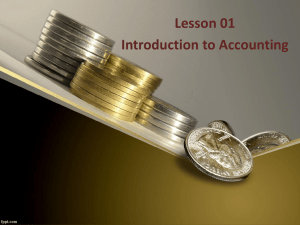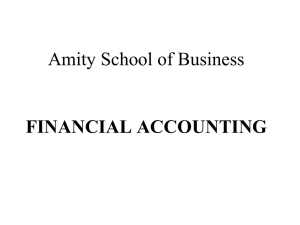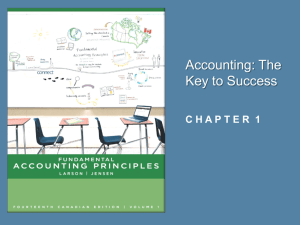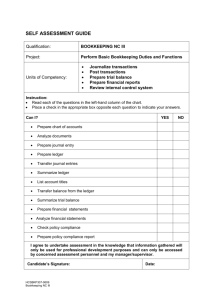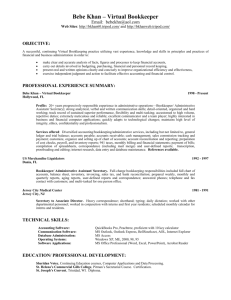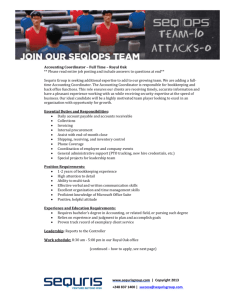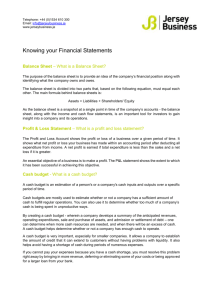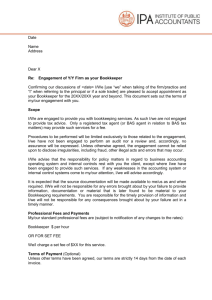week 01 – ORIENTATION & ACCOUNTING BASICS
advertisement
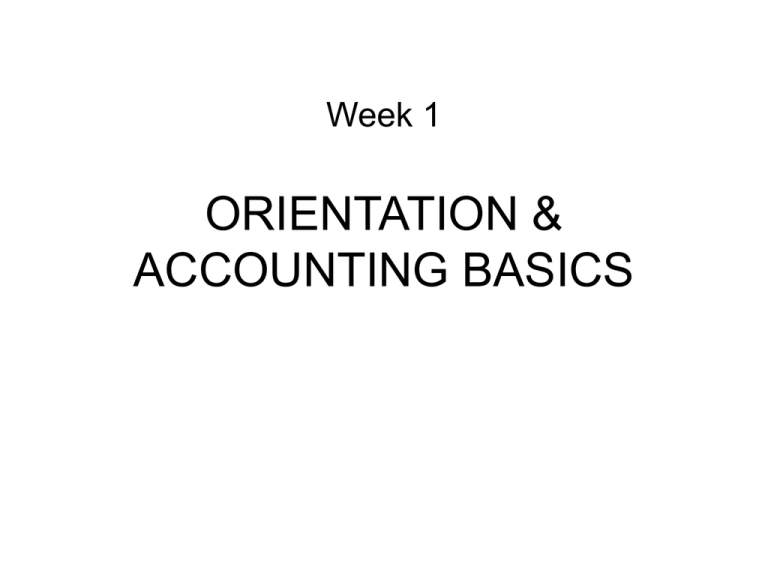
Week 1 ORIENTATION & ACCOUNTING BASICS COURSE OVERVIEW A. B. C. D. E. F. G. H. Course No.: IT200 Course Title: Accounting Information System No. of Units: 3 units Semester Offered: 1st Semester Lecturer: Mylene S. Caballero Consultation Hours: Tuesday 12:30 – 2:30 Linkage with Subsequent Courses: This course is not a prerequisite to any of the major subjects of the BSIT program. Schedule: A. B. C. D. IT3B – 8:00 – 11:00am lab. – Tues. IT3B – 4:10 – 5:40pm lec. – Tues. & Thurs. IT3A – 1:00 – 4:30pm lab. – Tues. IT3A – 1:00 – 4:05pm lec. – Thurs. COURSE OVERVIEW Course Description – This course introduces Computer Science and Information Technology majors to the basic accounting concepts and principles underlying financial statements of business enterprises. This course provides a theoretical basis for understanding accounting and system concepts as an introduction of Accounting Information Systems. The course contains in-depth coverage on transaction processing systems organized by cycles (Revenue, Expenditure, Conversion, and Financial Cycles). The course shows on how to use database theory and tools to build functional accounting systems per accounting transaction cycles. OBJECTIVES • Values to be integrated – This course aims to develop the critical thinking skills of the students as they try to portray the role of a systems analyst particularly in accounting information systems. They are expected to become good development planners equipped with the proper knowledge and values as they try to formulate humane decisions and solutions to real-world issues. TEXTBOOKS/REFERENCES 1. Basic Accounting by Win Lu Ballada 2. Basic Accounting by Edwin G. Valencia & Gregorio F. Roxas, 3rd edition 2009-2010 3. Fundamentals of Accounting by Rafael M. Lopez, Jr., Millennial edition 2007-2008 4. Accounting Information Systems by James Hall 5. Building Accounting Systems Using Access 2000 by James Perry & Gary Schneider, 2001 edition COURSE REQUIREMENTS • Assignments • Projects • Exams THE GRADING SYSTEM CLASSROOM POLICIES • Pray before and after the class. COURSE OUTLINE 1 – Accounting basics 2 – The accounting equation & the double-entry system 3 – Recording business transactions 4 – Adjusting the accounts 5 – Worksheet & financial statements 6 – Completing the accounting cycle 7 – Merchandising operations 8 – Overview of accounting information systems 9 – Accounting Information Cycles – Revenue Cycle, Expenditure Cycle, Conversion Cycle, Financial Cycle LEARNING OBJECTIVES • Discuss & differentiate forms of business organizations • Activities performed by business organizations • Define terms use in accounting • Explain & differentiate phases of accounting • Differentiate the difference between bookkeeping & accounting • Discuss different fundamental concepts What is an IT (INFORMATION TECHNOLOGY)? INFORMATION Data End user Data placed in a meaningful and useful context for an end user. in its various forms (business data, voice conversations, still images, motion pictures, multimedia presentations, and other forms). Anyone who uses an information system or the information it produces. TECHNOLOGY The scientific method and material used to achieve a commercial or industrial objective. Method used: The study, design, development, implementation, support or management of computer-based information systems. Material used: Computer Hardware and software application Commercial or Industrial objective: To create, convert, store, exchange, protect, process, transmit, and securely retrieve and use information in its various forms: What is an IT? Information technology (IT), is "the study, design, development, implementation, support or management of computer-based information systems, particularly software applications and computer hardware to create, convert, store, exchange, protect, process, transmit, and securely retrieve and use information in its various forms (business data, voice conversations, still images, motion pictures, multimedia presentations, and other forms) for anyone who uses an information system or the information it produces. Why do IT needs Accounting? Accounting is called the language of business. Is the medium of communication Bridging communication through Financial Information or Financial Statements Motive is profit. IT is a business. Why do IT needs Accounting? Accounting is called the language of business. Business Bridging communication through Financial Statements Various users (decision makers) Two-way communication Legal Forms of Business Organizations (Sole proprietorship, Partnership, Corporation, Cooperative) Internal user – Management Group (own, manage & control the business entity) External users – Financing Group and Public Group (do not own, manage & control the business entity) LEGAL FORMS OF BUSINESS ORGANIZATION 1.Sole Proprietorship 2.Partnership 3.Corporation 4.Cooperative Various Users (Decision Makers) Users of Accounting Information INTERNAL USERS MANAGEMENT GROUP Sole proprietors, partners, board of directors or stockholders, officers, managers, supervisors EXTERNAL USERS FINANCING GROUP Investors, potential investors, trade creditors or suppliers, potential creditors, lenders or banks & other financing institutions. PUBLIC GROUP Government regulatory agencies, taxing authorities, labor unions, employees, retirees, economic planners, customers ASSIGNMENTS 1. What are the legal forms of business organization? Differentiate them and state the name of the owner. 2. Give at least 10 users of Financial Statements. What decision they have to make? Why do Accounting needs IT? Information Technology's Role Today 1. All businesses need Computers 2. One of the first and largest applications of computers is keeping and managing business and financial records. 3. Large databases are managed by computer programs. 4. All the information companies need to do business involves the use of computers and information technology. What is Accounting? Accounting is the system that measures activities, processes that information into reports, and communicates the results to decision-makers. 1) measures business activities Measures through monetary value Business activities Servicing, Merchandising, Manufacturing, Agriculture Operating, investing & financing activities 2) Processes that information into reports, and 3) Communicates the results to decision-makers. Processes Communicates Accounting process through accounting cycle By means of Financial Statements information Financial information Reports Results Of Financial Statements Decision makers To Various users Balance Sheet, Income Statement ACTIVITIES PERFORMED BY BUSINESS ORGANIZATIONS SERVICING MANUFACTURING Perform services for a fee Raw materials into finished products MERCHANDISING Buy & sell finished products AGRICULTURE Plant, sell in raw or finished form WHAT IS ACCOUNTING? Accounting is the art of recording, classifying, summarizing in a significant manner and in terms of money, transactions and events which are, in part at least, of a financial character, and interpreting the results thereof. Art As an art, accounting demands critical thinking and creative skills. Accountants gather relevant data and convert them into organized financial reports. WHAT IS ACCOUNTING? Accounting is the art of recording, classifying, summarizing in a significant manner and in terms of money, transactions and events which are, in part at least, of a financial character, and interpreting the results thereof. Event Transaction In terms of money May be occasional to the business such as losses due to theft, calamity and decline in market value of inventory. Is sourced from ordinary business activities, such as selling, purchasing and producing. Before the effects of transactions can be recorded, they must be measured and expressed in terms of a common financial denominator---money. Are all business events and transactions accountable? PHASES OF ACCOUNTING 1. Identifying transactions and events – source documents 2. Journalizing transactions – the journal 3. Posting to the ledger – general ledger 4. Trial balance preparation 5. Adjusting journal entries 6. Preparing the worksheet 7. Preparing financial statements 8. Closing entries NOTE: Steps 1 to 10 is the ACCOUNTING CYCLE. 9. Post-closing trial balance 10. Reversing entries Profitability – How much is the increase in capital as a result of business operation? Liquidity – Are there available funds to finance the business operation? Solvency – Can the business pay its long-term obligations to others? BOOKKEEPING & ACCOUNTING (are two related processes.) BOOKKEEPER ACCOUNTANT BOOKKEEPING & ACCOUNTING (one is useless without the other) BOOKKEEPING ACCOUNTING (how accounting is done) (why accounting is done) 1. Refers to the mechanical aspect. 2. The process of recording “systematically” the business transactions in a “chronological manner”. Systematic – it follows procedures and principles. Chronological – the transactions are recorded in “order of the date of occurrence. 1. Refers to the analytical and interpretative aspects of accounting. 2. Requires complete and accurate bookkeeping records necessary to the performance of its responsibility. BOOKKEEPING & ACCOUNTING (one is useless without the other) BOOKKEEPING ACCOUNTING (how accounting is done) (why accounting is done) 3. An accounting support function. 4. Bookkeeper uses the accounting information system the accountant designs. 5. Bookkeeper is under the supervision of an accountant. 6. Alone could not arrive at the desired result of the entire accounting process. 3. Functions at a higher level or degree than bookkeeping. 4. Accountant designs the accounting information system that the bookkeeper will use. 5. Accountant supervises the work of bookkeepers. 6. Could not reach at this final point without first passing through the bookkeeping process. Other definition of Accounting • It is a service activity. Its function is to provide quantitative information, primarily financial in nature, about economic entities that is intended to be useful in making economic decisions. • It is the process of identifying, measuring and communicating economic information to permit informed judgments and decisions by users of the information. All of the above and previous definitions touch the most important points of accounting as: 1. Accounting is about quantitative information. 2. The information is of financial in character. 3. Usefulness of information in decision making. ACCOUNTING CONCEPTS OR ASSUMPTIONS • Are important assumptions or ideas which accountants observe in recording business transactions in the books of accounts. 1. Entity concept or accounting entity concept 2. Periodicity concept or time periods concept 3. Stable monetary unit concept or monetary unit concepts Accounting Entity Concept • • State that accountants regard a business enterprise as a separate and distinct entity from the person or people who own and run it. Business and personal transactions of the owner should not be merged. BUSINESS 1 Keep its own record BUSINESS 2 Keep its own record OWNER Keep its own record Transactions of different entities should be accounted for together. Periodicity or Time Period Concept • • An entity’s life can be meaningfully subdivided into equal time periods for reporting purposes. This concept allow the users to obtain timely information to serve as a basis on making decisions about future activities. CALENDAR YEAR A 12-month period (Jan. to Dec. 31 of the accounting period). FISCAL YEAR Composed of 12 months but starts from any month other than January. INTERIM PERIOD A business period within acx accounting period (weekly, monthly, quarterly, or semi-annual) When a financial report is prepared, it is importrant to indicate the date when it was prepared and the time period it covers. Monetary or Stable Monetary Unit Concept • • The Philippine peso is a reasonable unit of measure and that its purchasing power is relatively stable. It has the same purchasing power as any other peso at any time. This is the basis for ignoring the effects of inflation in the accounting records. QUANTIFIABILITY ASSUMPTION Accountants use a common unit of measurement that is, money. PESO STABILITY ASSUMPTION Accountants assume that the monetary unit retains its purhcasing power regardless of fluctuation in money value. With the adoption of IAS and IFRS, some accounting elements are measured at their fair market value.
